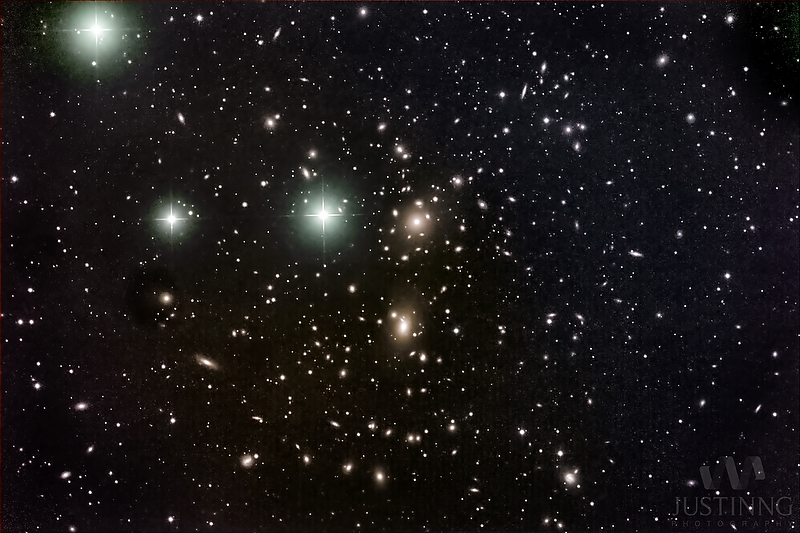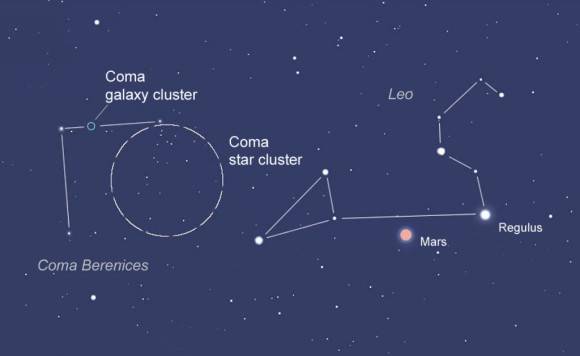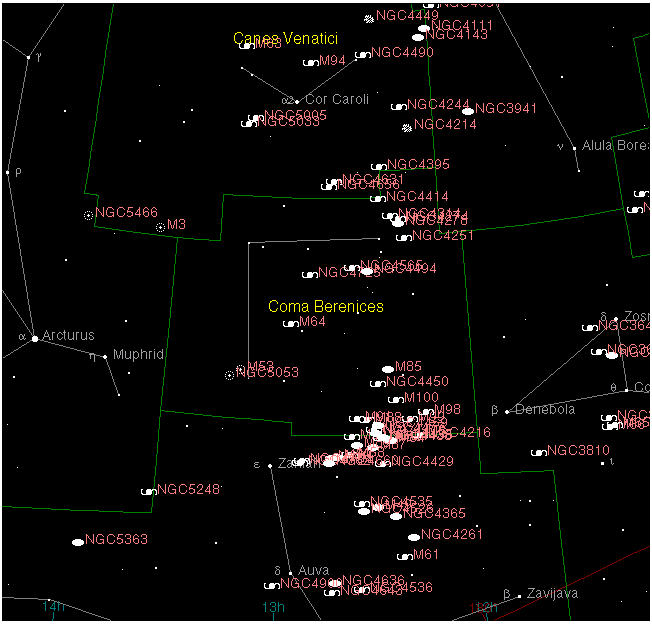

Almost every object you see in this photo is a galaxy. The Coma Cluster of galaxies contains as many as 10,000 galaxies, each housing billions of stars. Image via Justin Ng.
The Coma Cluster is a group of galaxies in the faint constellation Coma Berenices, visible in medium to large amateur telescopes. Coma Berenices lies between Leo and Boötes, and as such is most conveniently viewed in the evening sky of Northern Hemisphere spring and summer. The Coma Cluster is one of the richest galaxy clusters known. How many suns and how many worlds might be located in this direction of space?
An old but beautiful name for this region of sky is the Realm of the Galaxies.
The central part of Coma Cluster of galaxies covers a roughly circular area about a degree and a half across (9 times the area of a full moon), The full cluster may extend farther, and numerous other galaxy clusters are in the same area of sky.
How can you see it? The constellation Coma Berenices lies between the constellations Leo the Lion and Bootes the Herdsman. This part of the sky is the site of a famous open star cluster, and also of the more distant galaxy cluster, visible through telescopes. Both the star cluster and the galaxy cluster need a dark sky to be seen.
The galaxy cluster is is near the northern border of Coma Berenices, roughly midway a long a line drawn from Rho Bootes to Delta Leonis (Zosma), near the North Galactic Pole.

This map shows both the Coma star cluster and the Coma galaxy cluster, in the tail end of Leo the Lion. Three stars outline a simple triangle that forms the constellation Coma Berenices. Chart and caption via AstroBob

View larger. | The constellation Coma Berenices appears to the eye as a cluster of stars. But a telescope also reveals a vast region of distant galaxies in this part of the sky, which can be seen on this chart via SEDS.
Science of the Coma Cluster. The center of the Coma Cluster is about 320 million light years away, and it may stretch 20 million light years from side to side.
This cluster as a whole is flying away from us at the rate of about 6,900 km/second (more than 15 million miles per hour!)
One of the most populated galaxy clusters known, it contains as many as 10,000 or more members by some estimates. In any case there are more individual galaxies in this cluster than there are stars visible to the unaided human eye on a clear, dark night.
Most galaxies in the cluster are elliptical, although there are a few spiral galaxies. The two brightest members are NGC 4889 and NGC 4874, both of which are giant ellipticals at least 2 to 3 times larger than our own Milky Way galaxy.
Meanwhile, most galaxies in the Coma Cluster are dwarf galaxies, perhaps similar to the Milky Way’s companions, the Large and Small Magellanic Clouds.

Close-up on a majestic face-on spiral galaxy located deep within the Coma Cluster of galaxies. Image via NASA
Coma Cluster in history. Too faint to be seen by the human eye (or binoculars or even small telescopes), the ancients could not have seen the galaxy cluster and hence no mythology is associated with it. However, the Coma Cluster, also known as Abell 1656, is extremely interesting historically.
Not only is it one of the largest and most densely populated clusters of galaxies known, it is also the source of our first ideas about the dark matter in our universe. Unseen and mysterious, this matter greatly increases the total mass and gravitational strength of the universe, further affecting its evolution and fate.
Dark matter was unknown and unsuspected until Swiss-American astronomer Fritz Zwicky discovered it in the Coma Cluster in the 1930s. Zwicky tallied up the visible galaxies in the cluster and estimated its mass. Then he observed the motions of galaxies near the edge of the cluster, which are determined by the total gravity (and hence mass) of the cluster. Zwicky found that the mass derived from the latter method greatly exceeded that from visual inspection.
Zwicky knew that if the law of gravity is correct — and there is no reason to doubt it — the only answer could be an additional source of mass, which he called Dunkle Materie in German.
Today, the imprint of dark matter has been found throughout the universe, and is at least five times more prevalent than the more familiar visible matter, such as the stars and galaxies we can see.

Astronomer Fritz Zwicky first predicted the existence of dark matter in the 1930s following his observations of the Coma galaxy cluster. Image via zwicky-stiftung.ch
The center of the Coma Cluster is approximately RA: 12h 59m, dec: +27° 59?
Bottom line: How to locate the Coma Cluster of galaxies, plus history and science surrounding this fascinating region of the night sky.
from EarthSky http://bit.ly/2PiivPz


Almost every object you see in this photo is a galaxy. The Coma Cluster of galaxies contains as many as 10,000 galaxies, each housing billions of stars. Image via Justin Ng.
The Coma Cluster is a group of galaxies in the faint constellation Coma Berenices, visible in medium to large amateur telescopes. Coma Berenices lies between Leo and Boötes, and as such is most conveniently viewed in the evening sky of Northern Hemisphere spring and summer. The Coma Cluster is one of the richest galaxy clusters known. How many suns and how many worlds might be located in this direction of space?
An old but beautiful name for this region of sky is the Realm of the Galaxies.
The central part of Coma Cluster of galaxies covers a roughly circular area about a degree and a half across (9 times the area of a full moon), The full cluster may extend farther, and numerous other galaxy clusters are in the same area of sky.
How can you see it? The constellation Coma Berenices lies between the constellations Leo the Lion and Bootes the Herdsman. This part of the sky is the site of a famous open star cluster, and also of the more distant galaxy cluster, visible through telescopes. Both the star cluster and the galaxy cluster need a dark sky to be seen.
The galaxy cluster is is near the northern border of Coma Berenices, roughly midway a long a line drawn from Rho Bootes to Delta Leonis (Zosma), near the North Galactic Pole.

This map shows both the Coma star cluster and the Coma galaxy cluster, in the tail end of Leo the Lion. Three stars outline a simple triangle that forms the constellation Coma Berenices. Chart and caption via AstroBob

View larger. | The constellation Coma Berenices appears to the eye as a cluster of stars. But a telescope also reveals a vast region of distant galaxies in this part of the sky, which can be seen on this chart via SEDS.
Science of the Coma Cluster. The center of the Coma Cluster is about 320 million light years away, and it may stretch 20 million light years from side to side.
This cluster as a whole is flying away from us at the rate of about 6,900 km/second (more than 15 million miles per hour!)
One of the most populated galaxy clusters known, it contains as many as 10,000 or more members by some estimates. In any case there are more individual galaxies in this cluster than there are stars visible to the unaided human eye on a clear, dark night.
Most galaxies in the cluster are elliptical, although there are a few spiral galaxies. The two brightest members are NGC 4889 and NGC 4874, both of which are giant ellipticals at least 2 to 3 times larger than our own Milky Way galaxy.
Meanwhile, most galaxies in the Coma Cluster are dwarf galaxies, perhaps similar to the Milky Way’s companions, the Large and Small Magellanic Clouds.

Close-up on a majestic face-on spiral galaxy located deep within the Coma Cluster of galaxies. Image via NASA
Coma Cluster in history. Too faint to be seen by the human eye (or binoculars or even small telescopes), the ancients could not have seen the galaxy cluster and hence no mythology is associated with it. However, the Coma Cluster, also known as Abell 1656, is extremely interesting historically.
Not only is it one of the largest and most densely populated clusters of galaxies known, it is also the source of our first ideas about the dark matter in our universe. Unseen and mysterious, this matter greatly increases the total mass and gravitational strength of the universe, further affecting its evolution and fate.
Dark matter was unknown and unsuspected until Swiss-American astronomer Fritz Zwicky discovered it in the Coma Cluster in the 1930s. Zwicky tallied up the visible galaxies in the cluster and estimated its mass. Then he observed the motions of galaxies near the edge of the cluster, which are determined by the total gravity (and hence mass) of the cluster. Zwicky found that the mass derived from the latter method greatly exceeded that from visual inspection.
Zwicky knew that if the law of gravity is correct — and there is no reason to doubt it — the only answer could be an additional source of mass, which he called Dunkle Materie in German.
Today, the imprint of dark matter has been found throughout the universe, and is at least five times more prevalent than the more familiar visible matter, such as the stars and galaxies we can see.

Astronomer Fritz Zwicky first predicted the existence of dark matter in the 1930s following his observations of the Coma galaxy cluster. Image via zwicky-stiftung.ch
The center of the Coma Cluster is approximately RA: 12h 59m, dec: +27° 59?
Bottom line: How to locate the Coma Cluster of galaxies, plus history and science surrounding this fascinating region of the night sky.
from EarthSky http://bit.ly/2PiivPz

Aucun commentaire:
Enregistrer un commentaire